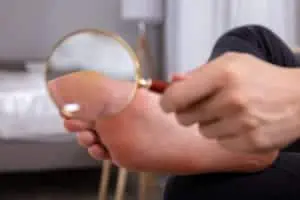
Medical Review By: Ted Schiff, MD
When you examine your feet, you’re probably more concerned about dry heels or nail problems than melanoma. After all, melanoma usually occurs in parts of the body that get a lot of sun exposure.
But foot melanoma — the skin cancer that killed reggae star Bob Marley — is real. And because they’re not looking for it, most people notice it too late, when it has already spread to other organs.
Foot melanoma can occur anywhere on the foot, including the top and bottom, between the toes, and even under a toenail. It can arise from an existing mole or from clear skin. It can strike any age group and is equally common in African Americans and Caucasians. For people of African or Asian descent, the feet and hands are the most common places for melanoma to develop.
No matter your skin color or age, the message is the same: Check your feet for melanoma.
What to look for
The signs are different depending on the type of foot melanoma, but be on the lookout for:
- A spot or growth that may be pinkish-red, brown, black, blue, white or some combination of these colors
- A new spot or growth that appears where you have injured your foot
- A sore that is slow to heal, does not heal or keeps coming back
- Pigment that spreads from a growth to the surrounding skin
- An open wound or sore that resembles a diabetic ulcer
- A dark vertical line under a toenail
Follow the ABCDE rule for evaluating skin spots and growths. Look for asymmetry (one side doesn’t match the other), an irregular border and changes in size, shape or color. A melanoma of the foot may feel tender, itch, ooze, bleed or become scaly.
Types of foot melanoma
Not all foot melanomas are the same. If you have foot melanoma, a dermatologist can determine which of these types it is:
Superficial spreading melanoma. This is the most common type of melanoma. When it affects the foot, it typically appears on the top. The spot or growth may be raised or flat and usually has an irregular shape. It may be tan, brown, black, red, blue, white or a combination of any of these colors. It gets larger before it penetrates deeper skin layers.
Acral lentiginous melanoma. This can develop on the sole of the foot or in the toenail bed. When it affects the sole, it looks like a flat, black or brown discoloration that gets larger over time. It may resemble a bruise or stain. When it develops in the bed of the nail (this condition is called subungual melanoma), it appears as dark vertical streaks. Subungual melanoma can cause cracks or breaks in the nail as it progresses.
Nodular melanoma. Nodular melanoma usually appears as a round bump or nodule. It’s usually black but can also be blue, gray, red or white. It may even be the same color as your skin. It spreads quickly. While anyone can develop nodular melanoma, it’s more common in people with light skin and over the age of 65.
Amelanotic melanoma. This a rare form of melanoma. It appears as a raised growth that is often skin-colored, which makes it hard to detect. The growth may also be red or pink. The best way to spot it is to look for any raised growth that is new or has changed. Risk factors include having red hair, pale and/or sun-sensitive skin, freckles and a lack of moles on your back.
Foot Melanoma Treatment
Your doctor will recommend a treatment based on your overall health and the stage of your skin cancer.
If the melanoma is caught early, the doctor may be able to cut out (excise) the growth and surrounding skin during an office visit. If the melanoma is advanced, it may require chemotherapy, radiation therapy, and/or immunotherapy. If cancer has spread to the lymph nodes, the nodes may need to be removed.
The best way to avoid more invasive treatment is to notice the signs of foot melanoma as soon as possible and see your dermatologist right away.
Article Written By: Jessica Brown, a health and science writer/editor based in Brooklyn, New York. She has written for Prevention magazine, jnj.com, BCRF.org and many other outlets.





